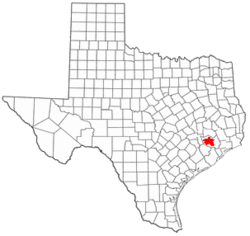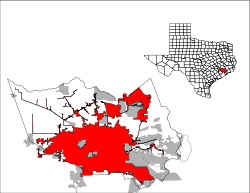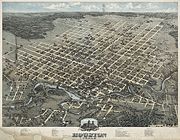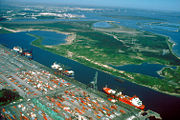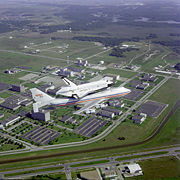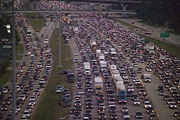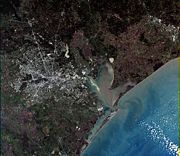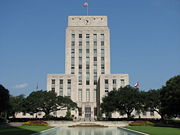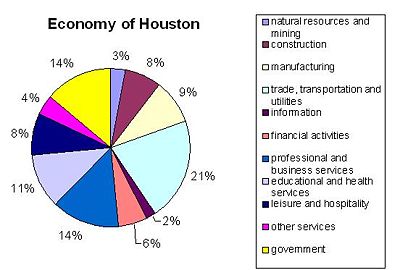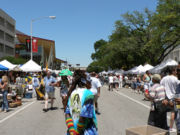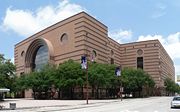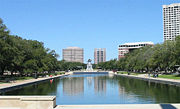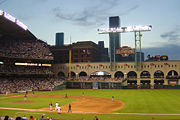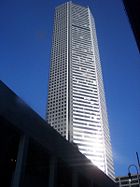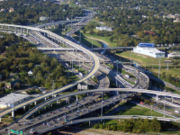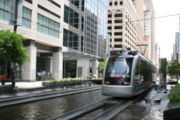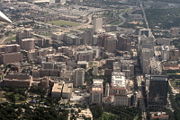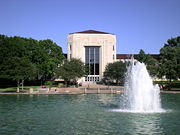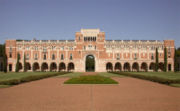Houston, Texas
2008/9 Schools Wikipedia Selection. Related subjects: Cities; North America
| City of Houston | |||
|
|||
| Nickname(s): Space City | |||
| Location in the state of Texas | |||
| Coordinates: | |||
|---|---|---|---|
| Country | United States of America | ||
| State | Texas | ||
| Counties | Harris Fort Bend Montgomery |
||
| Incorporated | June 5, 1837 | ||
| Government | |||
| - Mayor | Bill White | ||
| Area | |||
| - City | 601.7 sq mi (1,558 km²) | ||
| - Land | 579.4 sq mi (1,501 km²) | ||
| - Water | 22.3 sq mi (57.7 km²) | ||
| Elevation | 43 ft (13 m) | ||
| Population (2007) | |||
| - City | 2,231,000 ( 4th) | ||
| - Density | 3,853/sq mi (1,429/km²) | ||
| - Urban | 3,822,509 | ||
| - Metro | 5,628,101 ( 6th Largest) | ||
| - Demonym | Houstonian | ||
| Time zone | CST ( UTC-6) | ||
| - Summer ( DST) | CDT ( UTC-5) | ||
| Area code(s) | 713, 281, 832 | ||
| FIPS code | 48-35000 | ||
| GNIS feature ID | 1380948 | ||
| Website: houstontx.gov | |||
Houston (pronounced /ˈhjuːstən/) is the fourth-largest city in the United States of America and the largest city within the state of Texas. As of the 2006 U.S. Census estimate, the city has a population of 2.2 million within an area of 600 square miles (1,600 km²). Houston is the seat of Harris County and the economic centre of the Houston–Sugar Land–Baytown metropolitan area—the sixth-largest metropolitan area in the U.S. with a population of around 5.6 million.
Houston was founded on August 30, 1836 by brothers Augustus Chapman Allen and John Kirby Allen on land near the banks of Buffalo Bayou. The city was incorporated on June 5, 1837 and named after then-President of the Republic of Texas—former General Sam Houston—who had commanded at the Battle of San Jacinto, which took place 25 miles (40 km) east of where the city was established. The burgeoning port and railroad industry, combined with oil discovery in 1901, has induced continual surges in the city's population. In the mid-twentieth century, Houston became the home of the Texas Medical Centre—the world's largest concentration of healthcare and research institutions—and NASA's Johnson Space Centre, where Mission Control Centre is located.
Houston's economy has a broad industrial base in the energy, manufacturing, aeronautics, transportation, and health care sectors; only New York City is home to more Fortune 500 headquarters. Commercially, Houston is ranked as a gamma world city, and the area is a leading centre for building oilfield equipment. The Port of Houston ranks first in the United States in international waterborne tonnage handled and second in total cargo tonnage handled. The city has a multicultural population with a large and growing international community. It is home to many cultural institutions and exhibits—attracting more than 7 million visitors a year to the Houston Museum District. Houston has an active visual and performing arts scene in the Theatre District and is one of few U.S. cities that offer year-round resident companies in all major performing arts.
History
In August 1836, John Kirby Allen and Augustus Chapman Allen, two real estate entrepreneurs from New York City, purchased 6,642 acres (27 km²) of land along Buffalo Bayou with the intent of founding a city. The Allen brothers decided to name the city after Sam Houston, the popular general of the Texans at the Battle of San Jacinto, who was elected President in September 1836.
Houston was granted incorporation on June 5, 1837, with James S. Holman becoming its first mayor. In the same year, Houston became the county seat of Harrisburg County (now Harris County) and the temporary capital of the Republic of Texas. In 1840, the community established a chamber of commerce in part to promote shipping and waterborne business at the newly created port on Buffalo Bayou.
By 1860, Houston had emerged as a commercial and railroad hub for the export of cotton. Railroad spurs from the Texas inland converged in Houston, where they met rail lines to the ports of Galveston and Beaumont. During the American Civil War, Houston served as a headquarters for General John Bankhead Magruder, who used the city as an organization point for the Battle of Galveston. After the Civil War, Houston businessmen initiated efforts to widen the city's extensive system of bayous so the city could accept more commerce between downtown and the nearby port of Galveston. By 1890 Houston was the railroad centre of Texas.
In 1900, after Galveston was struck by a devastating hurricane, efforts to make Houston into a viable deepwater port were accelerated. The following year, oil discovered at the Spindletop oil field near Beaumont prompted the development of the Texas petroleum industry. In 1902, President Theodore Roosevelt approved a $1 million improvement project for the Houston Ship Channel. By 1910 the city's population had reached 78,800, almost doubling from a decade before. An integral part of the city were African Americans, who numbered 23,929 or nearly one-third of the residents. They were developing a strong professional class based then in the Fourth Ward.
President Woodrow Wilson opened the deepwater Port of Houston in 1914, seven years after digging began. By 1930, Houston had become Texas's most populous city and Harris the most populous county.
When World War II started, tonnage levels at the port decreased and shipping activities were suspended; however, the war did provide economic benefits for the city. Petrochemical refineries and manufacturing plants were constructed along the ship channel because of the demand for petroleum and synthetic rubber products during the war. Ellington Field, initially built during World War I, was revitalized as an advanced training centre for bombardiers and navigators. The M. D. Anderson Foundation formed the Texas Medical Centre in 1945. After the war, Houston's economy reverted to being primarily port-driven. In 1948, several unincorporated areas were annexed into the city limits, which more than doubled the city's size, and Houston proper began to spread across the region.
In 1950, the availability of air conditioning provided impetus for many companies to relocate to Houston resulting in an economic boom and producing a key shift in the city's economy toward the energy sector.
The increased production of the local shipbuilding industry during World War II spurred Houston's growth, as did the establishment in 1961 of NASA's "Manned Spacecraft Centre" (renamed the Lyndon B. Johnson Space Centre in 1973), which created the city's aerospace industry. The Astrodome, nicknamed the " Eighth Wonder of the World," opened in 1965 as the world's first indoor domed sports stadium.
During the late 1970s, Houston experienced a population boom as people from Rust Belt states moved to Texas in large numbers. The new residents came for the numerous employment opportunities in the petroleum industry, created as a result of the Arab Oil Embargo.
The population boom ended abruptly in the mid-1980s, as oil prices fell precipitously. The space industry also suffered in 1986 after the Space Shuttle Challenger exploded shortly after launch. The late 1980s saw a recession adversely affect the city's economy.
Since the 1990s, as a result of the recession, Houston has made efforts to diversify its economy by focusing on aerospace and health care/biotechnology and by reducing its dependence on the petroleum industry. In 1997, Houstonians elected Lee P. Brown as the city's first African American mayor.
In June 2001, Tropical Storm Allison dumped up to 37 inches (940 mm) of rain on parts of Houston, causing the worst flooding in the city's history; the storm cost billions of dollars in damage and killed 20 people in Texas. Many neighborhoods and communities have changed since the storm. By December of that same year, Houston-based energy company Enron collapsed into the second-largest ever U.S. bankruptcy during an investigation surrounding fabricated partnerships that were allegedly used to hide debt and inflate profits.
In August 2005, Houston became a shelter to more than 150,000 people from New Orleans who evacuated from Hurricane Katrina. One month later, approximately 2.5 million Houston area residents evacuated when Hurricane Rita approached the Gulf Coast, leaving little damage to the Houston area. This event marked the largest urban evacuation in the history of the United States.
Geography
According to the United States Census Bureau, the city has a total area of 601.7 square miles (1,558.4 km²); this comprises 579.4 square miles (1,500.7 km²) of land and 22.3 square miles (57.7 km²) of water.
Most of Houston is located on the gulf coastal plain, and its vegetation is classified as temperate grassland and forest. Much of the city was built on forested land, marshes, swamp, or prairie, which are all still visible in surrounding areas. Flatness of the local terrain, when combined with urban sprawl, has made flooding a recurring problem for the city. Downtown stands about 50 feet (15 m) above sea level, and the highest point in far northwest Houston is about 125 feet (38 m) in elevation. The city once relied on groundwater for its needs, but land subsidence forced the city to turn to ground-level water sources such as Lake Houston and Lake Conroe.
Houston has four major bayous passing through the city. Buffalo Bayou runs through downtown and the Houston Ship Channel, and has three tributaries: White Oak Bayou, which runs through the Heights neighbourhood and towards downtown; Braes Bayou, which runs along the Texas Medical Centre; and Sims Bayou, which runs through the south of Houston and downtown Houston. The ship channel continues past Galveston and then into the Gulf of Mexico.
Geology
Underpinning Houston's land surface are unconsolidated clays, clay shales, and poorly-cemented sands up to several miles deep. The region's geology developed from river deposits formed from the erosion of the Rocky Mountains. These sediments consist of a series of sands and clays deposited on decaying organic matter that, over time, transformed into oil and natural gas. Beneath the layers of sediment is a water-deposited layer of halite, a rock salt. The porous layers were compressed over time and forced upward. As it pushed upward, the salt dragged surrounding sediments into salt dome formations, often trapping oil and gas that seeped from the surrounding porous sands. The thick, rich, sometimes black, surface soil is suitable for rice farming in suburban outskirts where the city continues to grow.
The Houston area has over 150 active faults (estimated to be 300 active faults) with an aggregate length of up to 310 miles (500 km), including the Long Point-Eureka Heights Fault System which runs through the centre of the city. There have been no significant historically recorded earthquakes in Houston, but researchers do not discount the possibility of such quakes occurring in the deeper past, nor in the future. Land in some communities southeast of Houston is sinking because water has been pumped out from the ground for many years. It may be associated with slip along faults; however, the slippage is slow and not considered an earthquake, where stationary faults must slip suddenly enough to create seismic waves. These faults also tend to move at a smooth rate in what is termed " fault creep," which further reduces the risk of an earthquake.
Climate
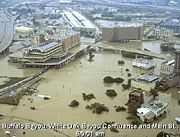
Houston's climate is classified as humid subtropical (Cfa in Köppen climate classification system). Spring supercell thunderstorms sometimes bring tornadoes to the area. Prevailing winds are from the south and southwest during most of the year, bringing heat across the continent from the deserts of Mexico and moisture from the Gulf of Mexico.
During the summer months, it is common for the temperature to reach over 90 °F (32 °C), with an average of 99 days per year above 90 °F (32 °C). However, the humidity results in a heat index higher than the actual temperature. Summer mornings average over 90 percent relative humidity and approximately 60 percent in the afternoon. Winds are often light in the summer and offer little relief, except near the immediate coast. To cope with the heat, people use air conditioning in nearly every vehicle and building in the city; in fact, in 1980 Houston was described as the "most air-conditioned place on earth". Scattered afternoon thunderstorms are common in the summer. The hottest temperature ever recorded in Houston was 109 °F (43 °C) on September 4, 2000.
Winters in Houston are fairly temperate. The average high in January, the coldest month, is 63 °F (17 °C), while the average low is 45 °F (7 °C). Snowfall is generally rare. The last snowstorm to hit Houston was on December 24, 2004. The coldest temperature ever recorded in Houston was 5 °F (−15 °C) on January 23, 1940. Houston receives a high amount of rainfall annually, averaging about 54 inches a year. These rains tend to cause floods over portions of the city.
Houston has excessive ozone levels and is ranked among the most ozone-polluted cities in the United States. Ground-level ozone, or smog, is Houston’s predominant air pollution problem, with the American Lung Association rating the metropolitan area's ozone level as the 6th worst in the United States in 2006. The industries located along the ship channel are a major cause of the city's air pollution.
| Weather averages for Houston | |||||||||||||
|---|---|---|---|---|---|---|---|---|---|---|---|---|---|
| Month | Jan | Feb | Mar | Apr | May | Jun | Jul | Aug | Sep | Oct | Nov | Dec | Year |
| Record high °F (°C) | 84 (29) | 91 (33) | 96 (36) | 95 (35) | 99 (37) | 103 (39) | 105 (41) | 107 (42) | 109 (43) | 97 (36) | 90 (32) | 85 (29) | 109 (43) |
| Average high °F (°C) | 62.3 (17) | 66.5 (19) | 73.3 (23) | 79.1 (26) | 85.5 (30) | 90.7 (33) | 93.6 (34) | 93.5 (34) | 88.9 (32) | 82.0 (28) | 72.0 (22) | 64.6 (18) | 79.4 (26) |
| Average low °F (°C) | 41.2 (5) | 44.3 (7) | 51.3 (11) | 57.9 (14) | 66.1 (19) | 71.8 (22) | 73.5 (23) | 73.0 (23) | 68.4 (20) | 58.8 (15) | 49.8 (10) | 42.8 (6) | 58.2 (15) |
| Record low °F (°C) | 5 (-15) | 14 (-10) | 22 (-6) | 31 (-1) | 44 (7) | 52 (11) | 62 (17) | 60 (16) | 46 (8) | 29 (-2) | 19 (-7) | 7 (-14) | 5 (-15) |
| Precipitation inches (mm) | 3.68 (93.5) | 2.98 (75.7) | 3.36 (85.3) | 3.60 (91.4) | 5.15 (130.8) | 5.35 (135.9) | 3.18 (80.8) | 3.83 (97.3) | 4.33 (110) | 4.50 (114.3) | 4.19 (106.4) | 3.69 (93.7) | 47.84 (1,215.1) |
| Source: National Weather Service June 2008 | |||||||||||||
Cityscape
Houston was incorporated in 1837 under the ward system of representation. The ward designation is the progenitor of the nine current-day Houston City Council districts. Locations in Houston are generally classified as either being inside or outside the Interstate 610 Loop. The inside encompasses the central business district and many residential neighborhoods that predate World War II. More recently, high-density residential areas have been developed within the loop. The city's outlying areas, suburbs and enclaves are located outside of the loop. Beltway 8 encircles the city another 5 miles (8 km) farther out.
Though Houston is the largest city in the United States without formal zoning regulations, it has developed similarly to other Sun Belt cities because the city's land use regulations and legal covenants have played a similar role. Regulations include mandatory lot size for single-family houses and requirements that parking be available to tenants and customers. Such restrictions have had mixed results. Though some have blamed the city's low density, urban sprawl, and lack of pedestrian-friendliness on these policies, the city's land use has also been credited with a bounty of affordable housing, sparing Houston the worst affects of the 2008 real estate crisis.
Voters rejected efforts to have separate residential and commercial land-use districts in 1948, 1962, and 1993. Consequently, rather than a single central business district as the centre of the city's employment, multiple districts have grown throughout the city in addition to downtown which include Uptown, Texas Medical Centre, Midtown, Greenway Plaza, Energy Corridor, Westchase, and Greenspoint.
Government and politics
The city of Houston has a strong mayoral form of municipal government. Houston is a home rule city and all municipal elections in the state of Texas are nonpartisan. The City's elected officials are the mayor, city controller and 14 members of the city council. As of 2007, the mayor of Houston is William "Bill" White, a Democrat elected on a nonpartisan ballot who is serving his third term and final term (due to term limits). Houston's mayor serves as the city's chief administrator, executive officer, and official representative. He is responsible for the general management of the city and for seeing that all laws and ordinances are enforced. As the result of a 1991 referendum in Houston, a mayor is elected for a two-year term, and can be elected to as many as three consecutive terms.
The current city council line-up of nine district based and five at large positions was based on a U.S. Justice Department mandate which took effect in 1979. At-large council members represent the entire city. Under the current city charter, if the population in the city limits goes past 2.1 million residents, the current nine-member city council districts will be expanded with the addition of two city council districts.
The city of Houston has been criticized for running the worst recycling program among the United States' 30 largest cities. In October 2008, the city will initiate a program where it will recycle heavy organic yard waste which is expected to salvage 90,000 tons annually, enough to fill the Chase Tower, the city's tallest structure.
Crime
Criminal Law is enforced by the Houston Police Department. Houston's murder rate ranked 11th of U.S. cities with a population over 250,000 in 2005. While nonviolent crime in the city dropped by 2 percent in 2005 compared to 2004, the number of homicides rose by 23.5 percent. Since 2005, Houston has been experiencing a spike in crime, which is due in part to an influx of people from New Orleans following Hurricane Katrina. After Katrina, Houston's murder rate increased 70 percent in November and December 2005 compared to levels in 2004. The city recorded 336 murders in 2005, compared to 272 in 2004.
Houston's homicide rate per 100,000 residents increased from 16.33 in 2005 to 17.24 in 2006. The number of murders in the city increased to 379 in 2006. In 1996, there were about 380 gangs with 8,000 members; of which 2,500 were juveniles.
Economy
Houston is recognized worldwide for its energy industry — particularly for oil and natural gas — as well as for biomedical research and aeronautics. The ship channel is also a large part of Houston's economic base. Because of these strengths, Houston is designated as a gamma world city by the Globalization and World Cities Study Group and Network.
Five of the six supermajor energy companies maintain a large base of operations in Houston (international headquarters of ConocoPhillips; US operational headquarters of Exxon-Mobil; US headquarters for international companies Shell Oil (US subsidiary of Royal Dutch Shell located in The Hague, Netherlands), and British Petroleum whose international headquarters are in London, England). Specifically, the headquarters of Shell Oil Company, the US affiliate of Royal Dutch Shell, is located at One Shell Plaza. While ExxonMobil maintains its small, global headquarters in Irving, Texas, its upstream and chemical divisions as well as most operational divisions, are located in Houston. Chevron has offices in Houston, having acquired a 40 story building intended to be the headquarters of Enron. The company's Chevron Pipe Line Company subsidiary is headquartered in Houston, and more divisions are being consolidated and moved to Houston each year. Houston is headquarters for the Marathon Oil Corporation and Citgo.
Greater Houston is a leading centre for building oilfield equipment. Much of Houston's success as a petrochemical complex is due to its busy man-made ship channel, the Port of Houston. The port ranks first in the United States in international commerce, and is the tenth-largest port in the world. Unlike most places, where high oil and gasoline prices are seen as harmful to the economy, they are generally seen as beneficial for Houston as many are employed in the energy industry.
The Houston–Sugar Land–Baytown MSA's Gross Area Product (GAP) in 2006 was $325.5 billion, slightly larger than Austria’s, Poland’s or Saudi Arabia’s Gross Domestic Product (GDP). When comparing Houston's economy to a national economy, only 21 countries other than the United States have a gross domestic product exceeding Houston's regional gross area product. Mining, which in Houston is almost entirely exploration and production of oil and gas, accounts for 11% of Houston's GAP; this is down from 21% in 1985. The reduced role of oil and gas in Houston's GAP reflects the rapid growth of other sectors, such as engineering services, health services, and manufacturing.
Houston ranks second in employment growth rate and fourth in nominal employment growth among the 10 most populous metro areas in the U.S. The unemployment rate in the city was 3.8% in April 2008, the lowest level in eight years while the job growth rate was 2.8%.
In 2006, the Houston metropolitan area ranked first in Texas and third in the U.S. within the Category of "Best Places for Business and Careers" by Forbes magazine. Forty foreign governments maintain trade and commercial offices here and the city has 23 active foreign chambers of commerce and trade associations. Twenty foreign banks representing 10 nations operate in Houston, providing financial assistance to the international community.
In 2008, Houston received top ranking on Kiplinger's Personal Finance Best Cities of 2008 list which ranks cities on their local economy, employment opportunities, reasonable living costs and quality of life. The city ranked fourth for highest increase in the local technological innovation over the preceding 15 years, according to Forbes magazine.. In the same year, the city ranked second on the annual Fortune 500 list of company headquarters. and ranked first for Forbes Best Cities for College Graduates.
Demographics
Houston is a diverse and international city, in part because of its many academic institutions and strong industries. Over 90 languages are spoken in the city. Houston has among the youngest populations in the nation, partly due to an influx of immigrants into Texas. The city has the third-largest Hispanic and third-largest Mexican population in the United States. An estimated 400,000 illegal immigrants reside in Houston. Houston has one of the largest South Asian (i.e., Indian and Pakistani) communities in the United States.
As of the census of 2000, there were 1,953,631 people and the population density was 3,371.7 people per square mile (1,301.8/km²). The racial makeup of the city was 49.27 percent White, 25.31 percent Black, 5.31 percent Asian, 0.44 percent American Indian, 0.06 percent Pacific Islander, 16.46 percent from some other race, and 3.15 percent from two or more races. Persons of Hispanic origin—who may be of any race—accounted for 37 percent of the population while non-Hispanic whites made up 30.8 percent.
Houston has a large population of immigrants from Asia, including the largest Vietnamese-American population in Texas and third-largest in the United States, with 85,000 people in 2006. Some parts of the city with high populations of Vietnamese and Chinese residents have Chinese and Vietnamese street signs, in addition to English ones. Houston has two Chinatowns: the original located in Downtown, and the more recent one north of Bellaire Boulevard in the southwest area of the city. The city has a Little Saigon in Midtown and Vietnamese businesses located in the southwest Houston Chinatown. A " Little India" community referred to as the "Harwin District" exists along Hillcroft.
Houston has a large gay community concentrated primarily in Montrose, Neartown and Houston Heights. It is estimated that the Houston metropolitan area has the twelfth-largest number of lesbian, gay and bisexual individuals in the United States.
Culture
Houston is a multicultural city with a large and growing international community. The metropolitan area is home to an estimated 1.1 million (21.4 percent) residents who were born outside the United States, with nearly two-thirds of the area's foreign-born population from south of the United States–Mexico border. Additionally, more than one in five foreign-born residents are from Asia. The city is home to the nation’s third largest concentration of consular offices, representing 86 countries.
Houston received the official nickname of "Space City" in 1967 because it is the location of NASA's Lyndon B. Johnson Space Centre. Other nicknames often used by locals include " Bayou City," "Magnolia City," "Clutch City," and "H-Town."
Arts and theatre
Houston has an active visual and performing arts scene. The Theatre District is located downtown and is home to nine major performing arts organizations and six performance halls. It is the second-largest concentration of theatre seats in a downtown area in the United States. Houston is one of few United States cities with permanent, professional, resident companies in all major performing arts disciplines: opera ( Houston Grand Opera), ballet ( Houston Ballet), music ( Houston Symphony Orchestra), and theatre ( The Alley Theatre). Houston is also home to many local folk artists, art groups and various smaller progressive arts organizations. Houston attracts many touring Broadway acts, concerts, shows, and exhibitions for a variety of interests.
Houston holds the Bayou City Art Festival, which is considered to be one of the top five art festivals in the United States.
The Museum District has many popular cultural institutions and exhibits, which attract more than 7 million visitors a year. Notable facilities located in the district include The Museum of Fine Arts, Houston Museum of Natural Science, the Contemporary Arts Museum Houston, Holocaust Museum Houston, and the Houston Zoo. Located in the nearby Montrose area are The Menil Collection and Rothko Chapel.
Bayou Bend, located in River Oaks, is a 14 acre facility of the Museum of Fine Arts that houses one of America's best collections of decorative art, paintings and furniture. Bayou Bend is the former home of Houston philanthropist Ima Hogg.
Many venues scattered across Houston regularly host local and touring rock, blues, country, hip hop and Tejano musical acts. Unfortunately, there has never been a widely renowned music scene in Houston. Artists seem to relocate to other parts of the United States once attaining some level of success. A notable exception to the rule is Houston hip-hop, which celebrates the unique southern flavor and attitude of its roots. This has given rise to a strong, independent hip-hop music scene, influencing and influenced by the larger Southern hip hop and gangsta rap communities. Many Houstonian hip-hop artists have attained commercial success.
Events
Many annual events celebrate the diverse cultures of Houston. The largest and longest running is the annual Houston Livestock Show and Rodeo, held over 20 days from late February to early March. Another large celebration is the annual night-time Houston Pride Parade, held at the end of June. Other annual events include the Houston Greek Festival, Art Car Parade, the Houston Auto Show and the Houston International Festival.
Tourism and recreation
Space Centre Houston is the official visitors’ centre of NASA's Lyndon B. Johnson Space Centre. Here one will find many interactive exhibits including moon rocks, a shuttle simulator, and presentations about the history of NASA's manned space flight program.
The Theatre District is a 17-block area in the centre of downtown Houston that is home to the Bayou Place entertainment complex, restaurants, movies, plazas, and parks. Bayou Place is a large multilevel building containing full-service restaurants, bars, live music, billiards, and art house films. The Houston Verizon Wireless Theatre stages live concerts, stage plays, and stand-up comedy; and the Angelika Film Centre presents the latest in art and foreign and independent films.
Houston is home to 337 parks including Hermann Park, which houses the Houston Zoo and the Houston Museum of Natural Science, Lake Houston Park, Memorial Park, Tranquility Park, Sesquicentennial Park, Discovery Green and Sam Houston Park which contains restored and reconstructed homes which were originally built between 1823 and 1905). Of the 10 most populous U.S. cities, Houston has the most total area of parks and green space: 56,405 acres (228 km²). The city also has over 200 additional green spaces—totaling over 19,600 acres (79 km²) that are managed by the city—including the Houston Arboretum and Nature Centre. The Houston Civic Centre was replaced by the George R. Brown Convention Centre—one of the nation's largest—and the Jesse H. Jones Hall for the Performing Arts, home of the Houston Symphony Orchestra and Society for the Performing Arts. The Sam Houston Coliseum and Music Hall have been replaced by the Hobby Centre for the Performing Arts.
Other tourist attractions include the Galleria (Texas's largest shopping mall located in the Uptown District), Old Market Square, the Downtown Aquarium, SplashTown and Sam Houston Race Park. The San Jacinto Battleground State Historic Site where the decisive battle of the Texas Revolution was fought is located on the Houston Ship channel east of the city; the park is also the location of the museum battleship USS Texas (BB-35).
Sports
Houston has teams for nearly every major professional sport. The Houston Astros ( MLB), Houston Texans ( NFL), Houston Rockets ( NBA), Houston Dynamo ( MLS), Houston Comets ( WNBA), Houston Aeros ( AHL), Houston Wranglers ( WTT), Houston Takers ( ABA), and the Houston Energy ( WPFL) all call Houston home.
Minute Maid Park (home of the Astros) and Toyota Centre (home of the Rockets, and Aeros) are located in a revived area of downtown. The city has the Reliant Astrodome, the first domed stadium in the world; it also holds the NFL's first retractable-roof stadium, Reliant Stadium. Other sports facilities in Houston include Hofheinz Pavilion, Reliant Arena (home of the Comets), and Robertson Stadium (both used for University of Houston collegiate sports, the latter also for the Houston Dynamo), and Rice Stadium (home of the Rice University Owls football team). The infrequently used Reliant Astrodome hosted World Wrestling Entertainment's WrestleMania X-Seven on April 1, 2001, where an attendance record of 67,925 was set. The city will host WrestleMania XXV at Reliant Stadium on April 5th, 2009.
Houston has hosted major recent sporting events, including the 2004 Major League Baseball All-Star Game, the 2000 IHL All-Star Game, the 2005 World Series, the 2005 Big 12 Conference football championship game, the 2006 NBA All-Star Game, the U.S. Men's Clay Court Championships from 2001–2006, and the Tennis Masters Cup in 2003 and 2004, as well as the annual Shell Houston Open golf tournament. The city hosts the annual NCAA College Baseball Minute Maid Classic every February and NCAA football's Texas Bowl in December. Houston has hosted the Super Bowl championship game twice. Super Bowl VIII was played at Rice Stadium in 1974 and Super Bowl XXXVIII was played at Reliant Stadium in 2004. In early 2006, the Champ Car auto racing series returned to Houston for a yearly race, held on the streets of the Reliant Park complex.
Architecture
Houston's skyline has been ranked fourth most impressive in the United States; it is the third-tallest skyline in the United States and one of the top 10 in the world. Houston has a seven-mile (11 km) system of tunnels and skywalks linking buildings in downtown which contain shops, restaurants, and convenience stores. This system enables pedestrians to avoid the intense summer heat and heavy rain showers while walking from one building to another.
In the 1960s, Downtown Houston consisted of a modest collection of mid-rise office structures, but has since grown into one of the largest skylines in the United States. Downtown was on the threshold of a boom in 1970 with huge projects being launched by real estate developers with the energy industry boom. A succession of skyscrapers were built throughout the 1970s—many by real estate developer Gerald D. Hines—culminating with Houston's tallest skyscraper, the 75-floor, 1,002-foot (305 m)-tall JPMorgan Chase Tower (formerly the Texas Commerce Tower), which was completed in 1982. It is the tallest structure in Texas, 10th-tallest building in the United States and the 30th-tallest skyscraper in the world based on height to roof. In 1983, the 71-floor, 992-foot (302 m)-tall Wells Fargo Bank Plaza was completed, which became the second-tallest building in Houston and Texas. Based on height to roof, it is the 13th-tallest in the United States and the 36th-tallest in the world. As of 2006, downtown Houston had about 43 million square feet (4,000,000 m²) of office space.
Centered on Post Oak Boulevard and Westheimer Road, the Uptown District boomed during the 1970s and early 1980s when a collection of mid-rise office buildings, hotels, and retail developments appeared along Interstate 610 west. Uptown became one of the most impressive instances of an edge city. The highest achievement of Uptown was the construction of the 64-floor, 901-foot (275 m)-tall, Philip Johnson and John Burgee designed landmark Williams Tower (known as the Transco Tower until 1999). At the time, it was believed to the be the world's tallest skyscraper outside of a central business district. The Uptown District is also home to other buildings designed by noted architects such as I. M. Pei, César Pelli, and Philip Johnson. In the late 1990s and early 2000s, there was a mini-boom of mid-rise and high-rise residential tower construction, with several over 30 stories tall. In 2002, Uptown had more than 23 million square feet (2,100,000 m²) of office space with 16 million square feet (1,500,000 m²) of Class A office space.
Transportation
Houston's freeway system is made up of 575.5 miles (926.2 km) of freeways and expressways in a ten-county metropolitan area. Its highway system uses a hub-and-spoke freeway structure serviced by multiple loops. The innermost loop is Interstate 610, which encircles downtown, the medical centre, and many core neighborhoods with around a 10-mile (16 km) diameter. Beltway 8 and its freeway core, the Sam Houston Tollway, form the middle loop at a diameter of roughly 25 miles (40 km). A proposed highway project, State Highway 99 (The Grand Parkway), would form a third loop outside of Houston. Currently, the completed portion of State Highway 99 runs from just north of Interstate 10, west of Houston, to U.S. Highway 59 in Sugar Land, southwest of Houston, and was completed in 1994.
Houston also lies along the route of the proposed Interstate 69 NAFTA superhighway that would link Canada, the U.S. industrial Midwest, Texas, and Mexico. Other spoke freeways either planned or under construction include the Fort Bend Parkway, Hardy Toll Road, Crosby Freeway, and the future Alvin Freeway.
Houston's freeway system is monitored by Houston TranStar, a partnership of four government agencies that are responsible for providing transportation and emergency management services to the region. Houston TranStar was the first centre in the nation to combine transportation and emergency management centers, and the first to bring four agencies ( Texas Department of Transportation, Harris County, Texas, Metropolitan Transit Authority of Harris County, Texas and the City of Houston) together to share their resources.
The Metropolitan Transit Authority of Harris County, Texas, or METRO, provides public transportation in the form of buses, light rail, and lift vans. METRO's various forms of public transportation still do not connect many of the suburbs to the greater city.
METRO began light rail service on January 1, 2004 with the inaugural track ("Red Line") running about 8 miles (13 km) from the University of Houston–Downtown ("UHD"), which traverses through the Texas Medical Centre and terminates at Reliant Park. METRO is currently in the design phase of a 10-year expansion plan that will add five more lines to the existing system.
Amtrak, the national rail passenger system, provides service to Houston via the Sunset Limited (Los Angeles–New Orleans), which stops at a train station on the north side of the downtown area. The station saw 10,855 boardings and alightings in fiscal year 2006.
Houston is served by two commercial airports, serving 52 million passengers in 2007. The larger is George Bush Intercontinental Airport (IAH), the ninth-busiest in the United States for total passengers, and seventeenth-busiest worldwide. Bush Intercontinental currently ranks third in the United States for non-stop domestic and international service with 182 destinations. In 2006, the United States Department of Transportation named George Bush Intercontinental Airport the fastest-growing of the top ten airports in the United States. Houston is the headquarters of Continental Airlines and Bush Intercontinental is Continental Airlines' largest hub. The airline offers more than 700 daily departures from Houston. In early 2007, Bush Intercontinental Airport was named a model "port of entry" for international travelers by U.S. Customs and Border Protection. The Houston Air Route Traffic Control Centre stands on the George Bush Intercontinental Airport grounds.
The second-largest commercial airport in Houston is William P. Hobby Airport (named Houston International Airport until 1967). The airport operates primarily small to medium-haul flights and is the only airport in Houston served by Southwest Airlines and JetBlue Airways. Houston's aviation history is showcased in the 1940 Air Terminal Museum located in the old terminal building on the west side of Hobby Airport.
Another airport is Ellington Field (a former U.S. Air Force base) that is used by military, government, and general aviation sectors.
The Federal Aviation Administration and the state of Texas selected the "Houston Airport System as Airport of the Year" for 2005, largely because of its multi-year, $3.1 billion airport improvement program for both major airports in Houston.
Greyhound Lines operates intercity services from five stations in Houston and several Houston suburbs. Other bus lines operate from Greyhound's stations and other stations.
Healthcare and medicine
Houston is the seat of the internationally-renowned Texas Medical Centre, which contains the world's largest concentration of research and healthcare institutions. All 45 member institutions of the Texas Medical Centre are non-profit organizations. They provide patient and preventive care, research, education, and local, national, and international community well-being. These institutions include 13 renowned hospitals and two specialty institutions, two medical schools, four nursing schools, and schools of dentistry, public health, pharmacy, and virtually all health-related careers. It is where one of the first—and still the largest—air emergency service, Life Flight, was created, and a very successful inter-institutional transplant program was developed. More heart surgeries are performed at the Texas Medical Centre than anywhere else in the world.
Some of the academic and research health institutions in the centre include Baylor College of Medicine, The University of Texas Health Science Centre at Houston, The Methodist Hospital, Texas Children's Hospital and The University of Texas M. D. Anderson Cancer Centre. The University of Texas M. D. Anderson Cancer Centre has consistently ranked as one of the top two U.S. hospitals specializing in cancer care by U.S. News & World Report since 1990.
Houston is the home of the Menninger Clinic, a renowned psychiatric treatment centre affiliated with Baylor College of Medicine and The Methodist Hospital.
Education
There are more than 55 colleges and universities and dozens of institutions engaged in research and development in Houston.
The University of Houston ("UH") is Texas's third-largest public research university with more than 40 research centers and institutes. UH, with more than 36,000 students from 130 countries, is one of the most diverse campuses in the country. The city is also the home to Rice University, one of the leading teaching and research universities of the United States and ranked the nation's 17th-best overall university by U.S. News & World Report. Other public institutions of higher learning in the city include University of Houston–Clear Lake ("UHCL"), University of Houston–Downtown ("UHD"), and Texas Southern University ("TSU"). Additionally, several private institutions include University of St. Thomas, who in 2008 was ranked one of "America's Best Colleges" by US News & World Report, and Houston Baptist University. The Houston Community College System serves most of Houston and is the fourth-largest community college system in the United States.
Houston is home to two of four public law schools in Texas: University of Houston Law Centre and Thurgood Marshall School of Law. The University of Houston Law Centre ranked in at No. 60 of the "Top 100 Law Schools" in 2007 by U.S. News & World Report. Additionally, South Texas College of Law—a private institution—is the city's oldest law school founded in 1923 and has one of the nation's top programs for trial advocacy. There are 17 school districts serving the city. The Houston Independent School District (HISD) is the seventh-largest in the United States. HISD has 112 campuses that serve as magnet or vanguard schools—specializing in such disciplines as health professions, visual and performing arts, and the sciences. There are also many charter schools that are run separately from school districts. In addition, some public school districts also have their own charter schools.
The Houston area is home to more than 300 private schools, many of which are accredited by Texas Private School Accreditation Commission (TEPSAC) recognized agencies. The Houston Area Independent Schools, or HAIS, offer education from a variety of different religious as well as secular viewpoints. The Houston area Catholic schools are operated by the Archdiocese of Galveston-Houston.
Sister cities
Houston has sixteen sister cities designated through the city's membership in Sister Cities International (SCI). The year each relationship was formed is shown in parentheses below.
|



